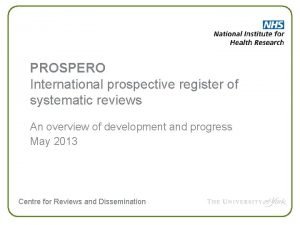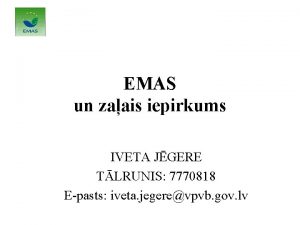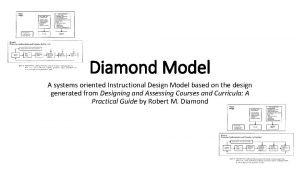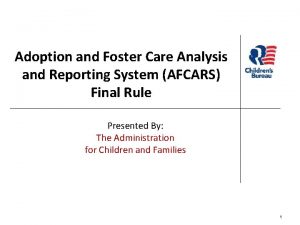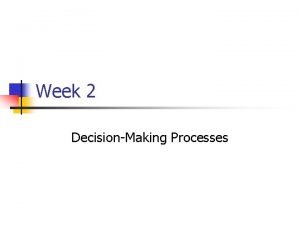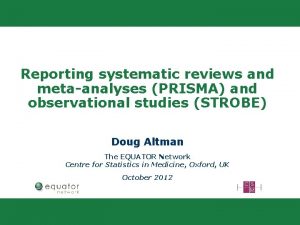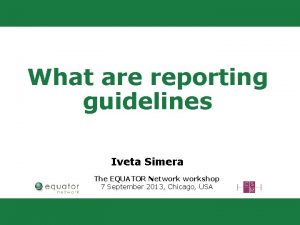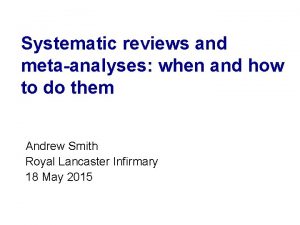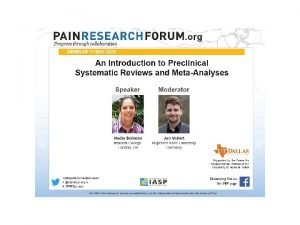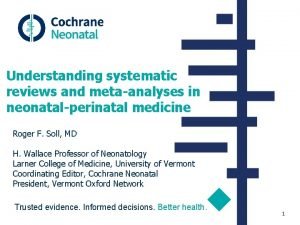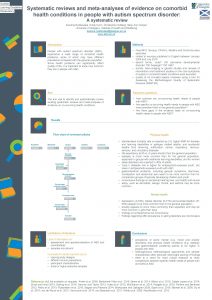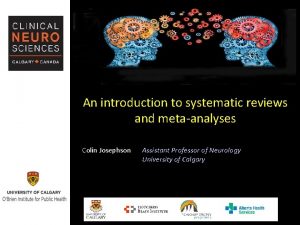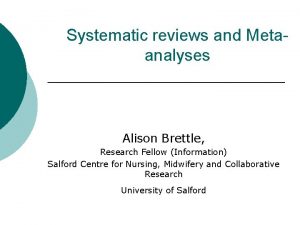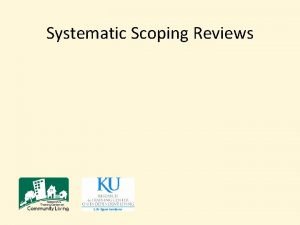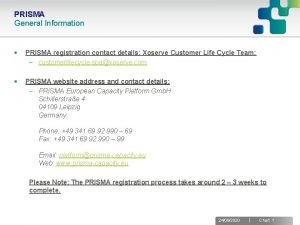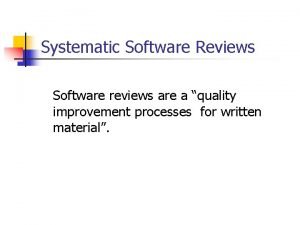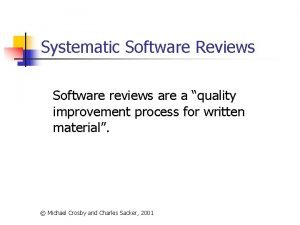Reporting systematic reviews and metaanalyses PRISMA Iveta Simera





























- Slides: 29

Reporting systematic reviews and meta-analyses: PRISMA Iveta Simera The EQUATOR Network Centre for Statistics in Medicine, Oxford, UK April 2012

Large number of studies – need to synthesise & summarise Source: Banzi et al. J of Med Internet Res; 2010, 12 (3) adapted from Haynes RB. Evid Based Med 2006; 11(6): 162 -164. Source: Evidence-based Nursing http: //ebp. lib. uic. edu/nursing/node/12 2

Different types of reviews • Narrative (overview) • Systematic review – Meta-analysis 3

Narrative reviews (NR) • Provide an overview of a particular topic • Often cover a wide range of issues within a given topic • Can be useful for understanding new concepts • But there are problems associated with NR: – they are rarely comprehensive – they do not reveal many details about their methodology – they are highly susceptible to reviewers’ bias – they seldom take into account differences in the quality of studies – they can often come to the wrong conclusion – careful interpretation needed 4

Example of NR 5

Systematic reviews (SR) • SR is a scientific investigation that focuses on a specific question and uses explicit, prespecified scientific methods to identify, select, assess, and summarise the findings of similar but separate studies. • It may include a quantitative synthesis (metaanalysis), depending on the available data [Eden et al. Finding what works in health care: Standards for systematic reviews, Institute of Medicine, 2011] 6

Systematic reviews (2) • The importance of SR is increasingly appreciated – Clinical practice guideline development – Clinical and policy decisions BUT • The quality of published SR is variable and often inadequate – In many cases we are unable to judge the quality of SR because the methodology is poorly reported or the SR is poorly conducted 7

Key characteristics of SR • Focused well defined research question • Clearly stated title and objectives • Comprehensive strategy for identification of all relevant studies (published & unpublished) • Explicit (and justified) predefined inclusion & exclusion criteria • Critical appraisal of studies • Clear analysis of the results of eligible studies – Quantitative (meta-analysis) – Qualitative • Structured report 8

Cochrane SR • Development of Cochrane SR is coordinated by the Cochrane Collaboration – – Established in 1993 International network of 28, 000 from 100 countries About 4, 600 Cochrane reviews published They are internationally recognised as a benchmark for high quality information about the effectiveness of healthcare http: //www. cochrane. org 9

Cochrane Library (CLIB) • All Cochrane reviews published in CLIB • Published by Wiley-Blackwell (indexed by Pub. Med, impact factor 6. 1) • Free access in the UK and many other countries http: //www. thecochranelibrary. com/ 10

Methodology of Cochrane reviews • Methodology robustly developed (continuous improvements) • Handbook – free online access: http: //www. cochrane. org/ training/cochranehandbook • Good to follow even if doing “non-Cochrane” SR • UK Cochrane Centre training 11

Process of conducting Cochrane SR • PROTOCOL – important – Minimise potential bias in the review conduct: Reviews are retrospective, need to establish the methods in advance – Planning – Review team – Cochrane protocols are peer reviewed and published 12

Cochrane review conduct – key points • Protocol • Objectives – Focused well defined research question – Primary outcome (one) – Minimum number of secondary outcomes – Include adverse events (harms) if relevant • Literature search – Comprehensive (electronic databases, grey literature, reference lists, personal communication, . . ) – Useful to involve an information specialist in developing search strategies (consider ss peer review) – Keep detailed record of search methods and search results! 13

Cochrane review conduct – key points (2) • Data collection and analysis – Selection of studies using predefined selection criteria – Independently done by more than one reviewer – Important to determine how to solve disagreements between reviewers • Data extraction – Data extraction form (pilot – items, format, . . ) – Independently done by more than one reviewer 14

Cochrane review conduct – key points (3) • Assessment of risk of bias – Problems with the design and execution of individual studies of healthcare interventions raise questions about the validity of their findings – In clinical trials, biases can be broadly categorized as selection bias, performance bias, detection bias, attrition bias, reporting bias and other biases that do not fit into these categories – Cochrane Collaboration developed the ‘Risk of bias tool’ 7 specific domains: • • sequence generation (selection bias) allocation concealment (selection bias) blinding of participants and personnel (performance bias) blinding of outcome assessment (detection bias) incomplete outcome data (attrition bias) selective outcome reporting (reporting bias) other potential sources of bias 15

Cochrane review conduct – key points (4) • Data synthesis – Qualitative: descriptive summary – Quantitative - meta-analysis: pooling data from a number of studies when there are • Minimal differences between studies • Outcome measured in the same way • Data are available Study weight Different statistical methods for pooling Subgroup analysis Sensitivity analysis 16

Interpretation of results • Clear statement of findings • Authors conclusions should reflect findings • Clear presentation is important • Summary of findings tables – Key information in a quick and accessible format – Relating the quality of evidence to the outcomes 17

Publishing SR • Differences between publishing SR in the Cochrane Library and in a journal: – Cochrane has some specific rules (e. g. titles structure: a title cannot start with ‘A’ or ‘The’; should not include ‘a systematic review of’) • Publishing in a journal: PRISMA Statement – Preferred Reporting Items for Systematic Reviews and Meta -Analyses (2009) – 27 -item checklist, flow diagram – PRISMA authors are also heavily involved in the Cochrane work, high compatibility of both guides http: //www. prisma-statement. org/ 18

Poor reporting of systematic reviews • Good reporting of primary studies is crucial for SR development BUT • Reviews are not immune to the problems of poor reporting – Moher et al. assessed epidemiological and reporting characteristics and bias-related aspects of 300 systematic reviews (of which 125 were Cochrane reviews). The overall quality of reporting of key aspects of methodology was very inconsistent with particularly discouraging findings for non-Cochrane reviews. [Moher; PLo. S Medicine 2007] 19

Example of bad reporting • Nowhere in the paper any mention of the review methodology! 20

Example of good reporting 21

PRISMA 2009 Checklist 22

PRISMA 2009 Checklist (2) 23

PRISMA 2009 Checklist (3) Methods - continued 24

PRISMA 2009 Checklist (4) Mistake in the published PRISMA papers: Item 21 should read Present the main results of the review. If meta-analyses are done, include for each, confidence intervals and measures of consistency 25

PRISMA 2009 Checklist (5) 26

PRISMA 2009 Flow diagram 27

PRISMA explanation & elaboration paper – Explanation and rationale for reporting of suggested information (items) – Examples of good reporting – Relevant data about how this information is reported presently Long but recommend to read to avoid basic mistakes in SR reports! Liberati A, Altman DG, Tetzlaff J, Mulrow C, Gøtzsche P, Ioannidis JPA, Clarke M, Devereaux PJ, Kleijnen J, Moher D, the PRISMA Group. The PRISMA statement for reporting systematic reviews and meta-analyses of studies that evaluate health care interventions: explanation and elaboration. • PLo. S Med 2009 6(7): e 1000100 • Annals of Internal Medicine 2009; 151: w 65 -w 94 • BMJ 2009; 339: b 2700. • Journal of Clinical Epidemiology 2009; PMID: 19631507 28

www. prisma-statement. org www. equator-network. org 29
 Prospero register
Prospero register Prisma smart soft
Prisma smart soft Iveta strode
Iveta strode Iveta fejkova wikipedia
Iveta fejkova wikipedia Iveta lielmane
Iveta lielmane Iveta jēgere
Iveta jēgere Iveta zelča
Iveta zelča Iveta kolářová matka lucie
Iveta kolářová matka lucie Iveta theuserová
Iveta theuserová Iveta mercep
Iveta mercep Vosviewer alternative
Vosviewer alternative A systematic statement of principles and generalizations
A systematic statement of principles and generalizations Systematic review definition
Systematic review definition Limitations of systematic sampling
Limitations of systematic sampling Systematic study of state and government
Systematic study of state and government What is random error
What is random error Deliberate and systematic manner
Deliberate and systematic manner Absolute error and relative error
Absolute error and relative error Aptitude intelligence and systematic forgetting
Aptitude intelligence and systematic forgetting The diamond model of curriculum development
The diamond model of curriculum development Systematic innovation of products processes and services
Systematic innovation of products processes and services Foster care analysis reporting system
Foster care analysis reporting system Programme approach
Programme approach Orfin and associates reviews
Orfin and associates reviews Skype for business review pros and cons
Skype for business review pros and cons It is the systematic regularity in rhythm
It is the systematic regularity in rhythm Hydromatic car
Hydromatic car Systematic decision making process
Systematic decision making process Steps in systematic desensitization
Steps in systematic desensitization Coverdale's 'systematic approach
Coverdale's 'systematic approach
